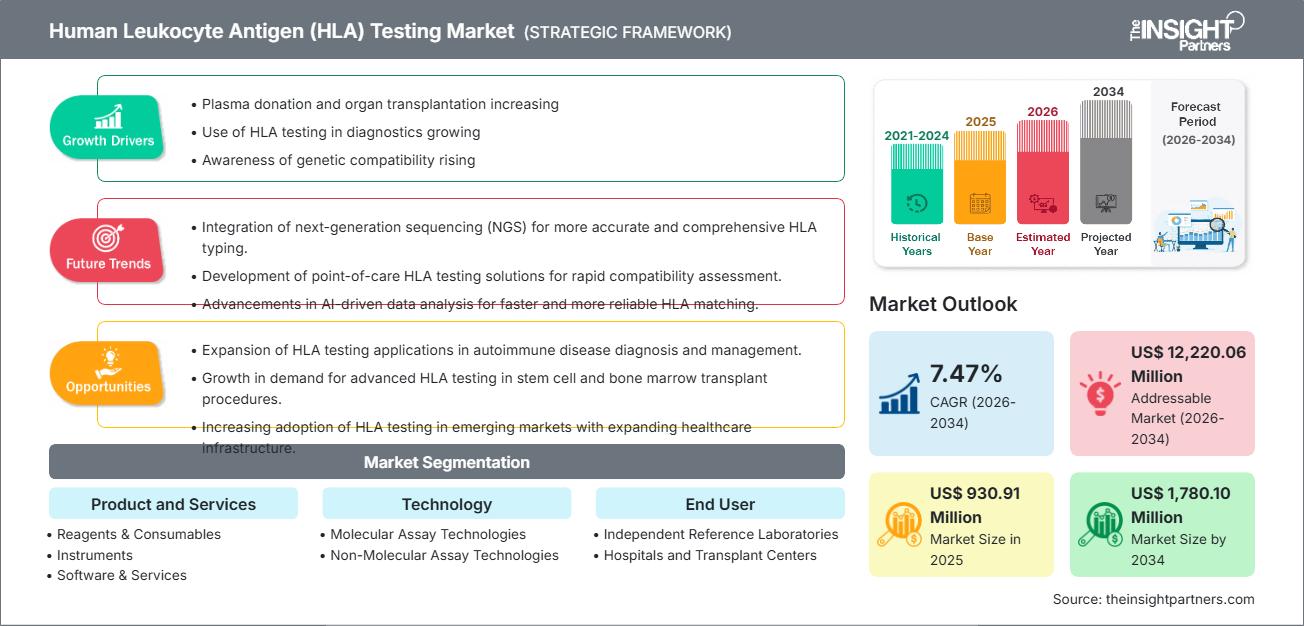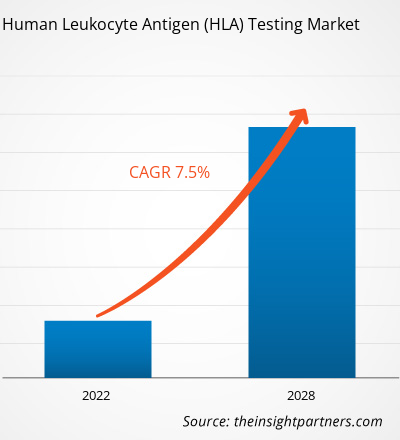Der Markt für HLA-Tests (Humanes Leukozyten-Antigen) wird bis 2034 voraussichtlich ein Volumen von 1.780,10 Millionen US-Dollar erreichen, gegenüber 930,91 Millionen US-Dollar im Jahr 2025. Es wird erwartet, dass der Markt im Prognosezeitraum von 2026 bis 2034 eine durchschnittliche jährliche Wachstumsrate (CAGR) von 7,47 % verzeichnen wird.
Marktanalyse für HLA-Tests
Die Marktprognose für HLA-Tests (Humanes Leukozytenantigen) deutet auf ein robustes Wachstum hin, das vor allem durch die steigende Nachfrage nach präziser Immunkompatibilitätsanalyse bei Transplantationen, den Trend zu hochauflösenden molekularen Methoden wie der Next-Generation-Sequenzierung (NGS) und die zunehmende Anwendung der HLA-Typisierung in der Diagnostik von Autoimmunerkrankungen und der Vorhersage von Arzneimittelüberempfindlichkeit (Pharmakogenomik) getrieben wird. Die kontinuierliche Integration von Automatisierungs- und Bioinformatik-Software, die den Durchsatz und das Datenmanagement in Testlaboren weltweit verbessert, trägt maßgeblich zum Marktwachstum bei.
Marktübersicht für HLA-Tests
Die HLA-Testung ist ein entscheidendes Diagnoseverfahren zur Bestimmung der Kompatibilität zwischen Spender und Empfänger bei Organ-, Gewebe- und Stammzelltransplantationen. HLA-Proteine, die sich auf der Oberfläche der meisten Zellen befinden, regulieren das Immunsystem. Ihre genaue Übereinstimmung ist unerlässlich, um das Risiko einer Transplantatabstoßung (Graft-versus-Host-Reaktion) zu minimieren und das Langzeitüberleben des Transplantats zu verbessern. Auch außerhalb der Transplantation gewinnt die HLA-Testung zunehmend an Bedeutung in der Diagnostik, insbesondere bei Zöliakie, rheumatoider Arthritis und anderen immunvermittelten Erkrankungen, sowie in der Pharmakogenomik zur Beurteilung des Ansprechens von Patienten auf bestimmte Medikamente. Der Markt ist stark auf Reagenzien und Verbrauchsmaterialien ausgerichtet, die aufgrund der wiederholten Testdurchführung und des hohen Probendurchsatzes in Referenzlaboren und Transplantationszentren über 70 % des Gesamtumsatzes ausmachen.
Passen Sie diesen Bericht Ihren Anforderungen an.
Sie erhalten eine kostenlose Anpassung aller Berichte – einschließlich Teilen dieses Berichts, Länderanalysen und Excel-Datenpaketen – sowie attraktive Angebote und Rabatte für Start-ups und Universitäten.
Markt für HLA-Tests: Strategische Einblicke

-
Ermitteln Sie die wichtigsten Markttrends dieses Berichts.Diese KOSTENLOSE Probe beinhaltet eine Datenanalyse, die von Markttrends bis hin zu Schätzungen und Prognosen reicht.
Markttreiber und Chancen für HLA-Tests
Markttreiber:
- Einführung hochauflösender molekularer Diagnostik: Der strategische Wandel von niedrigauflösenden serologischen Methoden hin zu hochauflösenden molekularen Techniken, insbesondere der Next-Generation-Sequenzierung (NGS), treibt den Marktwert an. NGS bietet eine überlegene Spezifität, schnellere Bearbeitungszeiten und die Möglichkeit, neue Allele zu detektieren, wodurch es zum Goldstandard für Kompatibilitätstests wird.
- Ausweitung der HLA-Testung bei Autoimmunerkrankungen und chronischen Krankheiten: Zunehmende klinische Evidenz, die bestimmte HLA-Allele mit Autoimmunerkrankungen (wie Typ-1-Diabetes und Morbus Bechterew) in Verbindung bringt, führt zu einer verstärkten Nutzung der HLA-Typisierung zur Bestätigung der Diagnose und zur Risikostratifizierung.
- Zunehmende Anwendungen in der Pharmakogenomik: HLA-Tests sind entscheidend für die Vorhersage von unerwünschten Arzneimittelwirkungen (z. B. Arzneimittelüberempfindlichkeitssyndrom im Zusammenhang mit bestimmten HIV- oder Antiepileptika) und erweitern damit ihren Anwendungsbereich über den traditionellen Transplantationskontext hinaus.
Marktchancen:
- Expansion in Schwellenländern: Entwicklungsländer, insbesondere im asiatisch-pazifischen Raum (China, Indien) sowie in Süd- und Mittelamerika, bieten erhebliches, bisher ungenutztes Potenzial. Der Ausbau der Gesundheitsinfrastruktur, steigende öffentliche und private Investitionen in diagnostische Verfahren und ein wachsender Pool an Transplantationskandidaten treiben die rasche Verbreitung molekularer Plattformen voran.
- Integration mit Automatisierung und künstlicher Intelligenz (KI): Die Nachfrage nach KI-gestützter Datenanalyse und automatisierten Laborabläufen schafft Möglichkeiten zur Entwicklung integrierter Softwarelösungen, die komplexe HLA-Daten schnell interpretieren, menschliche Fehler reduzieren und die Berichterstattung für Kliniker optimieren können.
- Entwicklung der Einzelzell-HLA-Transkriptanalyse: Neue Technologien, die sich auf die Einzelzellanalyse der HLA-Transkription konzentrieren, versprechen eine verbesserte Allelspezifität bei komplexen Analysen gemischter Proben und eröffnen neue Wege für die Präzisionsdiagnostik.
Marktbericht: Segmentierungsanalyse für HLA-Tests
Der Marktanteil von HLA-Tests wird in verschiedenen Segmenten analysiert, um ein besseres Verständnis seiner Struktur, der technologischen Landschaft und der Akzeptanzmuster der Endnutzer zu ermöglichen. Nachfolgend ist der in den meisten Branchenberichten verwendete Standard-Segmentierungsansatz dargestellt:
Nach Produkten und Dienstleistungen:
- Reagenzien und Verbrauchsmaterialien
- Instrumente
- Software & Dienstleistungen
Durch Technologie:
- Molekulare Testtechnologien
- Nichtmolekulare Testtechnologien
Vom Endbenutzer:
- Unabhängige Referenzlaboratorien
- Krankenhäuser und Transplantationszentren
Nach Geographie:
- Nordamerika
- Europa
- Asien-Pazifik
- Süd- und Mittelamerika
- Naher Osten und Afrika
Markt für HLA-Tests: Regionale Einblicke
Die regionalen Trends und Einflussfaktoren auf den Markt für HLA-Tests (Humanes Leukozytenantigen) im gesamten Prognosezeitraum wurden von den Analysten von The Insight Partners eingehend erläutert. Dieser Abschnitt behandelt außerdem die Marktsegmente und die geografische Verteilung des HLA-Testmarktes in Nordamerika, Europa, Asien-Pazifik, dem Nahen Osten und Afrika sowie Süd- und Mittelamerika.
Berichtsumfang zum Markt für HLA-Tests (Humanes Leukozytenantigen)
| Berichtattribute | Details |
|---|---|
| Marktgröße im Jahr 2025 | 930,91 Millionen US-Dollar |
| Marktgröße bis 2034 | 1.780,10 Millionen US-Dollar |
| Globale durchschnittliche jährliche Wachstumsrate (2026 - 2034) | 7,47 % |
| Historische Daten | 2021-2024 |
| Prognosezeitraum | 2026–2034 |
| Abgedeckte Segmente |
Nach Produkten und Dienstleistungen
|
| Abgedeckte Regionen und Länder |
Nordamerika
|
| Marktführer und wichtige Unternehmensprofile |
|
Marktteilnehmerdichte im Bereich HLA-Tests: Auswirkungen auf die Geschäftsdynamik verstehen
Der Markt für HLA-Tests (Humanes Leukozytenantigen) wächst rasant, angetrieben durch die steigende Nachfrage der Endverbraucher. Gründe hierfür sind unter anderem sich wandelnde Verbraucherpräferenzen, technologische Fortschritte und ein wachsendes Bewusstsein für die Vorteile des Produkts. Mit steigender Nachfrage erweitern Unternehmen ihr Angebot, entwickeln innovative Lösungen, um den Bedürfnissen der Verbraucher gerecht zu werden, und nutzen neue Trends, was das Marktwachstum zusätzlich beflügelt.

- Überblick über die wichtigsten Akteure im Markt für HLA-Tests (Humanes Leukozytenantigen)
Marktanteilsanalyse für HLA-Tests nach Regionen
Der Markt weist in den verschiedenen Regionen ein uneinheitliches Wachstum auf, das von den Gesundheitsausgaben, den regulatorischen Rahmenbedingungen und dem Transplantationsvolumen beeinflusst wird. Nachfolgend finden Sie eine Zusammenfassung der Marktanteile und Trends nach Region:
-
Nordamerika
- Marktanteil: Besitzt den größten Marktanteil aufgrund hoher Transplantationsvolumina, der frühen und obligatorischen Einführung fortschrittlicher molekularer Testverfahren (NGS) und etablierter Richtlinien zur Erstattung von Diagnoseleistungen.
- Wichtigste Einflussfaktoren: Hohe Prävalenz chronischer Krankheiten, die Organtransplantationen erforderlich machen; starke Präsenz wichtiger Marktteilnehmer; fortschrittliche Gesundheitsinfrastruktur.
- Trends: Kontinuierliche Integration von NGS-basierten Typisierungsverfahren und hochentwickelten Bioinformatik-Plattformen zur Dateninterpretation und -verwaltung.
-
Europa
- Marktanteil: Besitzt einen bedeutenden Marktanteil, was auf ausgereifte öffentliche Gesundheitssysteme und eine hohe Rate an Stammzell- und Organtransplantationen in wichtigen Ländern (Deutschland, Großbritannien, Frankreich) zurückzuführen ist.
- Wichtigste Einflussfaktoren: Strenge regulatorische Standards, die eine hochauflösende Typisierung erfordern; nationale/regionale Transplantationsregister, die die Standardisierung der Tests vorantreiben.
- Trends: Zunehmender Fokus auf Qualitätssicherung und externe Qualitätsbewertungssysteme (EQAS) zur Standardisierung der HLA-Typisierungsergebnisse auf dem gesamten Kontinent.
-
Asien-Pazifik
- Marktanteil: Es wird erwartet, dass dieser im Prognosezeitraum das schnellste Wachstum verzeichnen wird.
- Wichtigste Einflussfaktoren: Rasante Digitalisierung und Modernisierung der Gesundheitseinrichtungen; staatliche Unterstützung für Organspende- und Transplantationsprogramme in Ländern wie China und Indien; zunehmendes Bewusstsein für die Rolle von HLA bei der Krankheitsdiagnostik.
- Trends: Rasche Einführung von PCR- und NGS-Plattformen, Abkehr von älteren serologischen Methoden, angetrieben durch steigende Gesundheitsausgaben und Medizintourismus.
-
Süd- und Mittelamerika / Naher Osten und Afrika
- Marktanteil: Schwellenländer mit Entwicklungspotenzial, aber erheblichem Wachstumspotenzial.
- Wichtigste Einflussfaktoren: Steigende Investitionen im Gesundheitswesen, Ausbau privater Kliniken und spezialisierter Transplantationszentren sowie öffentlich-private Partnerschaften zur Verbesserung der Infrastruktur.
- Trends: Einführung kostengünstiger, automatisierter Instrumente und standardisierter Reagenzienkits zur effizienten Bewältigung steigender Testvolumina.
Marktteilnehmerdichte im Bereich der HLA-Tests: Auswirkungen auf die Geschäftsdynamik verstehen
Der Wettbewerb ist intensiv und wird von Unternehmen geprägt, die integrierte Lösungen anbieten, welche Reagenzien, Instrumente und Software kombinieren. Führende Anbieter konzentrieren sich auf Innovationen in der Molekulardiagnostik, insbesondere auf NGS-basierte Kits, um eine höhere Auflösung und schnellere Ergebnisse zu erzielen.
Wichtige Unternehmen auf dem Markt für HLA-Tests:
- Thermo Fisher Scientific Inc.
- CareDx
- Qiagen
- Illumina Inc.
- Bio-Rad Laboratories, Inc.
- TBG Diagnostics Limited
- F. Hoffmann-La Roche Ltd.
- Takara Bio Inc.
- Luminex Corporation
Hinweis: Die oben aufgeführten Unternehmen sind nicht in einer bestimmten Reihenfolge geordnet.
Marktneuigkeiten und aktuelle Entwicklungen im Bereich der HLA-Tests
- Qiagen demonstriert die Automatisierung von HLA-Typisierungsabläufen durch die Verwendung des QIAxcel-Kapillarelektrophoresesystems in Kombination mit Olerup SSP-Kits.
- Qiagen bietet außerdem das QIAseq xHYB Long Read HLA Typing Panel an, das die vollständige, hochauflösende Sequenzierung von HLA-Klasse-I- und -II-Allelen unter Verwendung von Langlesetechnologien wie PacBio und Oxford Nanopore ermöglicht.
- Illumina Inc. vermarktet NGS-basierte HLA-Typisierungslösungen mit ultrahochauflösender Typisierung unter Verwendung von SBS-Chemie und phasengerechten Paired-End-Reads.
- Illumina unterstützt das TruSight HLA v2 Sequenzierungspanel mit verbesserter Software, die die Erkennung struktureller Varianten um ca. 30 % verbessert. Das Unternehmen kündigte außerdem die Unterstützung der DRAGEN v4.4 Pipeline an, die eine HLA-Genotypisierung mit Zwei-Feld-Auflösung für Loci wie HLA-A, -B und -C ermöglicht.
- Die F. Hoffmann-La Roche AG bietet das LightMix Kit zum Nachweis von HLA-B27 mittels PCR-Schmelzkurvenanalyse auf LightCycler-Instrumenten an.
- Roche hebt außerdem seine NGS-basierten immunogenetischen Anwendungen hervor, zu denen auch die Unterstützung der HLA-Typisierung als Teil umfassenderer Sequenzierungslösungen gehört.
Marktbericht zu HLA-Tests: Abdeckung und Ergebnisse
Der Bericht „Marktgröße und Prognose für HLA-Tests (Humanes Leukozytenantigen) (2021–2034)“ bietet eine detaillierte Analyse des Marktes, die folgende Bereiche abdeckt:
- Marktgröße und Prognose für den Test auf humanes Leukozytenantigen auf globaler, regionaler und Länderebene für alle wichtigen Marktsegmente, die in den Geltungsbereich fallen.
- Trends im Markt für HLA-Tests sowie Marktdynamiken wie Treiber, Hemmnisse und wichtige Chancen.
- Detaillierte Wettbewerbsanalyse mit Marktkonzentration, Heatmap-Analyse, prominenten Akteuren und aktuellen Entwicklungen.
- Ausführliche PEST- und SWOT-Analyse des Marktumfelds.
- Detaillierte Unternehmensprofile und Wettbewerbsumfeld.
- Historische Analyse (2 Jahre), Basisjahr, Prognose (7 Jahre) mit CAGR
- PEST- und SWOT-Analyse
- Marktgröße Wert/Volumen – Global, Regional, Land
- Branchen- und Wettbewerbslandschaft
- Excel-Datensatz
Aktuelle Berichte
Erfahrungsberichte
Grund zum Kauf
- Fundierte Entscheidungsfindung
- Marktdynamik verstehen
- Wettbewerbsanalyse
- Kundeneinblicke
- Marktprognosen
- Risikominimierung
- Strategische Planung
- Investitionsbegründung
- Identifizierung neuer Märkte
- Verbesserung von Marketingstrategien
- Steigerung der Betriebseffizienz
- Anpassung an regulatorische Trends






















 Kostenlose Probe anfordern für - Markt für HLA-Tests
Kostenlose Probe anfordern für - Markt für HLA-Tests